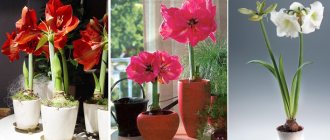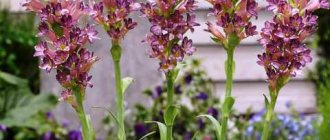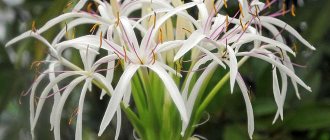Green shoots of crocuses (lat. Crocus), growing in open ground, appear on the soil surface even before the snow cover completely melts. These primroses are not afraid of cold weather and are ready to withstand return frosts. Their flowering time will last about 20 days if it doesn’t get warmer outside. But, if spring is very early and friendly, crocuses will bloom for only 7-10 days. On the street, flower beds, alpine slides, and various flower beds are decorated with crocuses.
Flowers are valued for the beauty that, according to ancient Roman legend, was given to them by the god Mercury. The flowers were named God in memory of his friend Crocus, who accidentally died at the hands of Mercury himself.
The flowers have another name - saffron, which is how the ancient Arabs called the bright yellow seasoning for eating from the stamens of one of the species of wild crocus. They also used it as a remedy. Saffron, as a refined spice, is still popular among the population of European and Eastern countries.
Wild crocuses came to Europe during the years of the Crusades. Flowers whose petals were painted yellow first appeared in the gardens of aristocrats. Already in the 16th century, breeding work began and decorative varieties of saffron were developed. But wild crocuses are still used by traditional healers to treat urolithiasis, liver disease, and as an anthelmintic.
Description of the plant
Crocus
in a pot can become a bright accent for the spring and winter holidays.
This plant is
very tender and delicious.
It usually begins to bloom in the spring, after the snow has melted, a little later than snowdrops. Some varieties of Crocuses
may bloom in autumn.
Homeland of Crocus
is located in the tropics of the Mediterranean, but even in our climate it lives quite comfortably.
If to Crocuses
If you apply specific methods, you can achieve their flowering for a specific holiday, for example, the New Year.
Types of crocuses
Crocuses can be natural or decorative, and they differ mostly in color. Natural - yellow, orange, blue or purple, and sometimes - snow-white albinos. But cultivated varieties can be almost anything, including spotted and multi-colored.
Spring crocus
This is one of the first garden varieties and the so-called large-flowered Dutch hybrids. It is common in the Pyrenees, Alps and Balkans and blooms in early spring. Spring crocus flowers are white, lilac or even two-tone.
Beautiful crocus
This is a Crimean and Caucasian mountain variety, which is still found in some regions of Iran and Turkey. It has large lilac petals with dark veined patterns and a bright orange center. Snow-white or even blue flowers are less common.
Narrow-leaved crocus
This variety is more common in the Balkans, Asia Minor and Crimea, and better tolerates mid-latitude conditions. It is relatively small and has elongated narrow leaves. The flowers of this crocus are pale yellow, but sometimes the petals are painted like a gradient from bright to faded.
Yellow crocus
The yellow crocus came to our latitudes from the countries of Southern Europe, and its main feature is obvious from the name. The yellow flowers are so bright and saturated that sometimes the shade fades into orange. The outer petals are decorated with grayish or purple stripes.
Seeding crocus
This is the same saffron that has been successfully cultivated for several thousand years. It is not found in the wild and arrived in our latitudes from Southwest Asia. Saffron is mentioned in ancient Greek manuscripts, and is supposedly a hybrid of three different natural species. It has purple, blue, yellow or white flowers with a long, bright pistil, which are dried as a spice.
Golden crocus
Golden crocus resembles yellow in its rich hue of flowers, but is in a different category. These are Chrysanthus varieties, which are traditionally smaller and brighter than the Dutch hybrids. The golden crocus begins to bloom even before the snow completely disappears from the ground.
Two-flowered crocus
The peculiarity of this variety is a huge variety of shades, and in natural conditions, without experiments by breeders. There are even purple, blue and lilac flowers with purple or brown veins. In nature, the two-flowered crocus is common in South-East Europe.
Seeding saffron
The sown species is one of the most cultivated in the world. It is grown on an industrial scale, since its flowers are known to everyone as the spice “saffron”, used in the preparation of various dishes. India is considered its homeland, and the one that is grown now is a hybrid version, born as a result of crossing several varieties. This low-growing plant has white or light purple flowers with a pleasant violet aroma.
The leaves appear along with the flowers, and all the beauty of the blooms can be observed for two weeks. Moreover, each flower lives no more than three days.
Crocus Pallas
A rather low-growing saffron has a height of no more than 50 mm. Its single flowers, which seem like outlandish stars, have delicate violet-pink shades with a purple base, and the diameter of the bud reaches 5 cm. The first narrow-line leaves appear in mid-spring, and saffron blooms in September. This contrasting spectacle of miniature flowers against the backdrop of a fading garden can be observed throughout the month.
Crocus Tomasini
This species is distinguished by its unpretentiousness, therefore it is quite popular, especially among lazy gardeners who want to have a beautiful garden plot without unnecessary hassle. The plant thrives in shaded areas, quickly adapts to any conditions and does not require special care. In the wild, the Tomasini crocus can be found in the Balkans, Bulgaria and Hungary. The flowers have pink-lilac shades with a white center.
During vigorous flowering, the crop forms an excellent continuous carpet, which looks great in the foreground of the lawn, as well as under the crowns of trees that have not yet blossomed. This crop can be grown indoors in pots.
Several flowerpots with different types of saffron will create an interesting decorative composition at home. They are often planted for some holidays - March 8, Valentine's Day, etc. For this, hybrid Dutch varieties are chosen, which are unpretentious and have a large number of buds with large flowers. These include the crocus “Joan of Arc” with white flowers, “Striped Beauty” with variegated colors, and the bright yellow “Lajest Yellow”.
Crocus at home - planting and care
Choosing a pot
Crocuses
usually planted in wide pots with a shallow bottom. Plant rooting in them is very favorable. A good layer of drainage must be placed at the bottom of the pot, after which soil with excellent air and water permeability is filled.
The reaction of the soil in the pot should be neutral. Its beneficial properties mean absolutely nothing, since for future growth and flowering all the most necessary and necessary properties are located directly in the bulb.
Flower growers who are aware of such secrets force the flower in sand or expanded clay.
What you need to grow crocuses
Growing saffron at home does not require significant effort or financial costs. For rapid growth and lush flowering of crocuses at home, it is enough to follow a few simple rules, including proper lighting, maintaining temperature conditions, and proper seed preparation.
Choosing the optimal place in the house
To grow saffron at home, it is recommended to choose a well-lit place where there are no drafts and high humidity. Dry air can also harm the plant, so it is not recommended to place pots with plants in close proximity to heat sources, for example, radiators, electric heaters.
Selection and preparation of containers
Before planting, be sure to wash the pots with laundry soap, scald with boiling water and dry thoroughly.
This must be done both when reusing containers and after purchasing a new pot.
To create a beautiful flower arrangement, you can plant crocuses at home in a pot by combining several different varieties. A prerequisite for this is the relatively small height of the container into which the plant will be transplanted, as well as the wide diameter of the pot.
When planting, it is important to ensure that the bulbs and seeds do not touch each other, as well as the walls of the pot, as this can cause a lack of flowering or the death of the plant.
Soil selection
To obtain lush and long flowering of saffron, plants should be grown in accordance with certain conditions. These include, for example, the correct choice of soil and preparation of pots. It is necessary to put some kind of drainage at the bottom of the container, for example, expanded clay, sand or small pebbles are perfect.
To allow excess moisture to escape, you need to make holes in the bottom of the pot.
Planting a flower, or rather its bulb, requires a soil mixture consisting of turf, rotted parts of plants and sand. Before planting, you need to slightly moisten the soil mixture.
Preparing seeds and bulbs for planting
Immediately before forcing, it is necessary to cool the plant bulbs for several hours. If suitable conditions are not available, you can use the refrigerator. It is important to remember that only well-dried onions can be refrigerated. As for the seeds, for rapid growth, three days before planting, you can soak them in warm water.
Creating the necessary conditions
To grow crocuses at home, it is recommended to keep the flowers indoors where the temperature does not exceed +15°C. Until the length of the sprout is five or more centimeters, saffron should be grown in a dark place.
Care involves maintaining the humidity regime. Plants do not tolerate increased amounts of water, which is why it is recommended not to water crocuses, but to lightly spray them with a spray bottle.
Care for long-term flowering
If your Crocuses
stopped blooming, and you want to identify the reason for this, you need to analyze the conditions of their maintenance.
It should be remembered that Crocus
is the first spring flowering plant and it may simply not like temperatures of twenty degrees or higher or an overly bright room.
In order to prolong the flowering of home Crocus
, it must be removed away from direct sunlight or bright light from a lamp. The temperature should be kept cool. During the day it is usually 15 degrees, at night 0.
If you care for the plant correctly, you can keep the plant decorative for up to three weeks.
Features of growing crocuses on the window
In city apartments, central heating radiators are located directly under the window sills, which make the air dry. Since crocuses need relatively high humidity, it is recommended to spray the plants with a spray bottle as often as possible.
When watering or spraying saffron, you need to remember that moisture on the petals provokes their darkening and a negative change in appearance.
Plant care
Crocuses, like any other plants, require mandatory care. Failure to comply with a number of basic rules may well lead to the death of plants, lack of flowers, and premature death of buds.
Watering
The plant should be watered only during the flowering period, that is, before early autumn. In the future, watering is carried out only as the soil dries out. It is strictly forbidden to grow crocuses in conditions of high humidity, as this can lead to rotting of the plants and damage to the bulbs.
Top dressing
It is necessary to feed the plants, but this should be done only during the active flowering phase. It is recommended to carry out nutrient addition procedures three times throughout the calendar year. The best feeding options are the following: mineral, organic.
Possible problems during cultivation
At Crocuses
, which bloom in spring and autumn, do not always have the same development cycles, and therefore the time of planting. This means that autumn types of flowers must be planted in the summer, and spring flowers in the fall, in September.
When purchasing material, you should always pay attention to the flowering season. For forcing, the spring type of Crocus
.
If tubers of different sizes and varieties are planted in one pot, then they will begin to bloom, accordingly, at very different times with different colors. And, of course, it will not look the most aesthetically pleasing.
Natural varieties of potted plants are not very decorative. And even with the most careful care of them, they will still be small. For them, planting in the garden is most suitable. For crops intended to be grown in pots, large-flowered plant varieties should be chosen.
If Crocus
The leaves have turned yellow, this is the first sign of chlorosis. This disease usually results from unfavorable conditions such as poor nutrition, poor drainage or damage to the bulb.
What varieties of crocuses are used for forcing?
It is best to use large-flowered varieties of spring crocus, or Dutch hybrids, for forcing, which include:
- crocuses of purple-blue color Grand Maitre, Flower Record, Vanguard, Grand Lila, Remembrans, Purpureus Grandiflorus;
- white crocus Joan of Arc;
- yellow varieties Lajest Yellow, Dorothy, Romance, Saturnus;
- reddish-purple Ruby Giant;
- bluish-white Prince Claus and Blue Pearl;
- variegated varieties Pickwick, Striped Beauty
and other varieties of this group.
Planting material of bulbous flower crops is calibrated by analysis, that is, by the size of the bulbs, and the most spectacular flowering at home is provided by large bulbs with a diameter of 2.8 -3.2 cm, each of which forms 5-6 flowers, as well as planting material with a diameter of 2.5-2.8 cm, forming at least 3 flowers. Small corms produce fewer flowers, which are smaller in size than the flowers formed by large bulbs.
Diseases and pests
If you notice that the petals on your plant are deformed and do not open, and light spots have appeared on the buds, then it is probably Crocus
affected by a viral infection.
In this case, the plant should be immediately destroyed, and the soil in which it was located should be treated with potassium permanganate.
Crocus bulbs
may be affected by fungus. In this case, they become soft, and spotted formations begin to appear under their scales.
Before planting, to prevent fungal diseases, the bulbs must be thoroughly dried and treated with special means.
Necessary conditions: lighting, humidity, temperature
For successful forcing, you need to create favorable conditions for growth, select the right lighting and temperature at which the crocuses will quickly enter the growth phase.
Temperature:
- The bulbs should be kept at a temperature of +30 degrees for the first week after digging.
- The next 2 weeks - at a temperature of +20 degrees.
- Until August - at +17 degrees.
- Before landing - at +8 degrees.
- After planting the bulbs, the pots are moved to a dark room with a temperature of +3 degrees for 15-16 weeks.
- After the sprouts appear, the temperature should be +10 degrees.
- Then it is raised to +17 degrees.
The rooting period corresponds to winter. The later the crocuses are planned to bloom, the more the bulbs should be in the cold and dark.
Sprouted crocuses are placed on the sunny side and wait for them to bloom. It is not recommended to bring pots into the heat suddenly; the temperature should be increased gradually.
See also
Description of the best varieties of cosmos, planting and care in open groundRead
Caring for Crocuses in the open ground
On Crocus
They are grown quite easily, since their care is practically minimal. The most difficult thing in the whole process is probably digging up and planting the tubers. But you don't need to do it every year.
Water crocuses after they are planted and until the end of the flowering period. If the winter was not snowy, then the flowers will need early watering in the spring.
Crocus
is a drought-resistant plant. It does not tolerate excessive soil wetting, although the height of its flower stalks depends directly on the amount of moisture received by the bulbs.
From time to time, from the moment the bulbs sprout until the end of flowering, you should loosen the soil under the flowers. Crocus tubers
need air flow. If loosening is not carried out, the air will be blocked by the soil crust that forms on the surface.
It is necessary to very carefully weed the flowers from weeds that take away nutrition from the bulbs. In many species of Crocus
Due to the lack of leaves, which appear only when flowers appear, weeds can significantly reduce the decorative value of plantings.
Plants need to be fed often and a lot. They really prefer organics. It is applied twice during the growing season. But it cannot be fresh manure, only rotted material.
Plants also have a great need for minerals. Especially in potassium and phosphorus. Twice in one season you can add a combined mineral complex.
The first feeding of spring plants is best done with a complex of minerals while still in the snow. And autumn ones are fertilized two weeks after planting with organic matter.
After the plants fade and the leaves turn yellow, care stops until the very moment of digging.
Features of planting bulbous crops
In order for the crocus to bloom, you need to know how to plant it correctly. Planting takes place in several stages, the first of which is the selection of bulbs.
Selection of planting material
When choosing bulbs, both their condition and size are important. The health of plants and the splendor of their flowering depend on them. Consider each one carefully:
- Refrain from purchasing planting material if rot, spots, or any damage is visible.
- If after purchase you still notice that there are defects, carefully cut out this part of the onion, and disinfect the damaged areas with ash or charcoal.
- The bulbs need to be thoroughly dried before planting (crocuses from the store have usually already been subjected to this treatment).
- Prepared crocuses should be cleared of scales, soil and root debris.
- The number of flowers a bulb will produce and the time it blooms directly depend on its size. Small bulbs often produce only one flower, which quickly falls off.
Botanical varieties of crocuses, that is, taken from flower beds, are not suitable - their buds are small and quickly fade.
Cooling
After purchasing, the bulbs are cooled. The temperature decrease occurs in two stages:
- For 7-10 days the temperature should be about +20 degrees, then – 17.
- Another 20-30 days should be kept wrapped in thick paper in the refrigerator or frost-free cellar. Temperature – from +3 to +9.
After this, the plants are ready to be planted in a pot.
Rooting
After cooling, it is necessary to prepare the soil mixture, and the prepared bulbs can be planted. They are placed at a distance of 10 centimeters from each other and from the walls of the pot. You can bury it completely, to a depth of 5-10 centimeters, or leave a “tail” on top. After this, the pot is placed in a dark and cool place and kept there for 2 months, during which the crocuses will sprout.
Planting is also allowed in which the bulbs are simply laid out on the ground, especially if you decide to plant a lot of saffron at once. Crocuses also take root successfully, but the stems are not as straight.
How to grow a plant from seeds
This method of propagating Crocuses
is used extremely rarely, since plants planted in this way begin to bloom only five years after they are planted in the soil.
To grow crocuses
Thus, it is necessary:
*Sow seeds in spring at the end of March or late autumn. The seeds are first soaked in a growth stimulator for forty minutes, after which they are placed in a weak solution of potassium permanganate.
*Before sowing, seeds should be stratified. Pour wet sand into a not very deep container and sow seeds in it. There is no need to bury them in the ground; simply distribute them on the surface. Cover the top with film and place in the refrigerator in the vegetable compartment. The container should be kept there for three weeks.
*When the time comes, remove the container from the refrigerator and place it in a bright and warm place.
*After the seedlings appear, they need to be watered. For watering, it is recommended to use a fine spray.
*When the plants grow a little, they are planted in separate containers or directly in the flowerbed.
Features of forcing
Forcing crocuses is a special procedure. In a short period of time you can grow a large flower with a long flowering period.
Selection of planting material
A high-quality bulb must meet the following requirements:
- Dense structure, uniform dark brown color of the husk.
- Absence of any mechanical damage on the surface of the nodule.
- Healthy scales without rot, mold, or unpleasant odor.
- The diameter of a good bulb is at least 7 cm. It is believed that a large tuber is the key to large flowers.
Important! The bulb should be in a state of complete rest. The presence of sprouts and roots will not allow the flower to germinate by the desired date.
Cooling
Planting crocuses in the ground - 70–80 days before the desired flowering
It is important to refrigerate the bulbs until this time. Often a regular refrigerator is used for this.
Saffron tubers are placed in a paper bag, placed in a cellar, refrigerator with a temperature within +3...8 ° C for a period of 25 to 30 days.
Rooting, flowering
It is better to plant crocuses in flat, wide containers; the flower takes root in them faster
How to plant crocuses in a pot at home? It is important to adhere to the following algorithm of actions:
- Place drainage at the bottom of the bowl. It can be expanded clay, broken brick, polystyrene foam. Without drainage, water will stagnate, causing the bulb to rot.
- Add a small amount of soil.
- Place the planting material in the center.
- Cover with soil so that a very thin layer of soil remains above the tail.
Advice! If the goal is to grow only flowers, without subsequent propagation of the bulb, then sand can be used instead of soil.
The pot of crocuses should be kept in a cool, dark place until germination.
Sprouted saffrons should be kept at a temperature no higher than +20 °C, otherwise flowering will occur faster than expected and will be short-lived. Water once every 20 days.
If flowering is planned for March, then the planting material is cooled in November, and the bulbs are planted in the ground in December.
Possible difficulties
Let's take a closer look at the following possible difficulties when growing crocuses in a pot:
- A common mistake gardeners make when growing crocus is choosing the wrong variety; you need to know that for forcing it is preferable to take spring varieties; work with them begins in the first month of autumn;
- If you water the plant excessively, the leaves will begin to turn yellow and the bulbs may become infected with foulbrood.
- When buying planting material (bulbs), you need to find out their flowering period; spring types of saffron are planted in September, and autumn types in summer;
- If crocuses are not provided with proper care and protection from adverse factors, their leaves will begin to turn yellow, which can lead to chlorosis.
The question often arises of how to protect the crocus so that it does not freeze on the balcony. Let's consider options with an open and closed balcony.
- In open, unprotected conditions, pots of crocuses are provided with a special shelter. To do this, use boxes or drawers in which containers with plants are placed, having previously covered the bottom of the prepared container with foam plastic or planks. The free space inside is filled with sawdust, paper or other dry filler. Wood shavings work well for this task. Burlap or bubble wrap is placed on top of such a shelter; you can take any non-woven material available.
- If the plants are in a glassed room, you need to ensure that the soil in the pots does not dry out. Flowers need regular watering. In this case, they will not need such specific protection as in the first option, but “wrapping up” the crocuses won’t hurt either. In winter, pots are not left on the floor; they are placed on special benches or stands; you can wrap them in old knitted items, burlap or other improvised means.
For information on how to plant crocuses, see below.
Crocuses at home are grown by forcing, which consists of creating conditions for the crop to bloom abundantly at a time when in nature it is dormant. This type of bulbous plant is easy to care for; with some effort, even a novice gardener can make it bloom by a certain date: New Year, March 8 or May 1. For successful forcing of home crocus, it is necessary that the bulbs go through several stages of pre-planting preparation, are planted on time and then kept at a certain temperature and humidity. Let's take a closer look at the procedure for growing crocuses at home.
Forcing crops by March 8
By spring, crocuses are driven out in the same way as in winter. The only difference is the determination of planting dates. They shift by several weeks.
How to select planting material
To force crocuses, it is best to use healthy, large bulbs without signs of damage. Baby bulbs are not suitable for this purpose; nothing will grow from them, because the bulb is still too small. It is better to leave it for planting in open ground. In the first year, even outside it is unlikely to bloom.
Planting crocuses for forcing
By March 8, the forcing period falls on October-November. For planting, use the same substrate as in the case of winter forcing. In principle, the process is not much different.
During planting, some people prefer not to deepen the bulb and leave it on the surface until about halfway. Only with such planting of planting material can crocuses grow crooked. Plant the bulbs in a common container. Planting material can be planted close to each other.
Planting crocuses
Planting is a process where, after planting, the bulbs are placed in a warm room and the temperature is gradually increased so that the bulbs begin to grow. Installation occurs at a temperature of +15…+17 degrees. The temperature is increased for 2-3 days after the pots are placed in the sun.
During the establishment stage, the soil is kept constantly moist. It is not necessary to feed crocuses, unless you plan to transplant them into open ground after flowering. In this case, mineral fertilizers for bulbous plants are added to the soil after the pot is moved to a warm place and after flowering.
The best types and varieties for growing
At the moment, scientists have been able to identify about 80 individual varieties of crocuses, as well as more than 300 varietal crops of this plant. Below we will present the botanical varieties and varieties of crocuses that are most often used by gardeners. All crocuses can be divided into only 3 independent varieties depending on their flowering period.
- Early spring. This group includes all varieties of saffron whose flowering period occurs at the end of winter or the very first days of spring. The species is frost-resistant and usually grows up to 9 cm in height.
- Spring flowering or large flowering. Varieties from this group usually bloom 2-3 weeks after the early spring varieties bloom. Such plants are distinguished by their large height of up to 15 cm and contrasting bright flowers of white, purple and blue.
- Autumn blooming. This includes all varieties of saffron, the flowering period of which is September-November. The color here can be very different - from white and yellow to purple with stripes.











